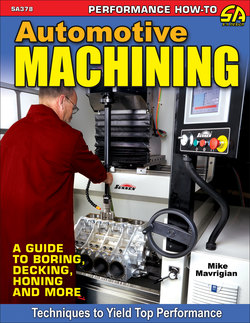Читать книгу Automotive Machining - Mike Mavrigian - Страница 6
На сайте Литреса книга снята с продажи.
ОглавлениеINTRODUCTION
As an engine builder, you need machine shop services for a stock rebuild, modified, or high-performance engine. Whether you’re an avid enthusiast or considering machining as a profession, this volume covers all critical operations of engine machining, so you have a clear understanding of the process and how to perform certain procedures yourself.
Although professionals are often required to perform automotive machining processes, it does not preclude the avid enthusiast from performing some machining and being closely involved in the machining process during an engine rebuild or high-perfomance build.
A typical automotive machine shop contains hundreds of thousands of dollars of machining equipment. Even a hard-core consumer cannot afford, nor is it practical, to buy this equipment. As a consequence, an at-home engine builder needs to contract a qualified machine shop for engine machining services. If you’re investing thousands of dollars in an engine build, you need to thoroughly understand these engine machining procedures, so you can guide the process and confirm that the correct results have been achieved. When your head, block, intake manifolds, and many other parts have been machined, you need to inspect, measure, and verify that the components are to specification.
Once all machining is complete, the assembly will be performed either by you or the machine shop. These critical components need to precisely fit together. The tolerances between components is exacting and can be as little as .0001 inch. It is incumbent upon you to invest in a set of tools to measure and verify the work that has been performed. This includes a C-clamp micrometer, caliper micrometer, dial indicator, dial bore gauge, bore gauge fixture, depth gauge, feeler gauge, pushrod measurement tool, machinist’s straightedge, torque wrench, torque plus angle gauge, ultrasonic tester, and other specialty tools and materials for engine building. With these tools, you are able to analyze and evaluate the machine shop work. Equally as important, these tools provide the means to take critical measurements during engine assembly. As a result, you are able to assemble the engine with precision, and this helps ensure that you have a strong-running and reliable engine.
The information provided in this book is intended both for the aspiring engine machinist and the performance consumer. It provides valuable insight into the processes involved in engine machining and assembly. You are given a complete tour of machining necessary for a typical engine build, and beyond that, you are shown the steps to machine engine parts for a build. All the parts of the engine must be compatible and complementary; a certain set of parts requires precise machining so the engine can operate as designed.
In many cases, an engine builder starts with a thoroughly used and tired engine that’s in need of a rebuild. In this book, you are instructed how to properly clean all engine components using bead blaster, soda blasting, chemical, and ultrasonic cleaning methods. You’re shown how to inspect and evaluate the engine block to ensure that it’s a worthy rebuilding candidate. In addition, you learn about the inspection of all components in the engine, so you can identify past problems, current solutions, and determine which parts are worth saving and which ones are not.
When it comes to block machining, main bore aligning, cylinder and cam tunnel honing, and boring are covered. Cylinder sleeving is often required in the engine building process, and that is also revealed. Truing the surfaces of the block deck ensures a seal between the block and the heads. A crankshaft is subjected to all kinds of opposing loads and as it accumulates hours of operation, it can bend, the journals can wear, and suffer other problems.
Measuring, machining, and other parts of crankshaft preparation are covered in detail. Connecting rods are the highest stressed components in an engine, and therefore, if yours are to be reused, they must be thoroughly inspected and properly reconditioned. In particular, the selection and installation of the connecting rod bolts must be done correctly to ensure that there is no failure because a connecting rod failure will likely destroy the entire engine.
You are shown how to install guides, machine and install valveseats, true the deck surface, measure the combustion chambers, and all the other critical steps to returning heads to their full health. Pistons and rings must be properly fitted to the bore of a particular engine block, so the process for fitting the ring to the cylinder and ring filing is covered.
Chapters provide information on rotating assembly balancing, blueprinting, clearance checking, CNC machining, port matching, pushrods, connecting rods, and more. Also included is an overview of final engine assembly tips.
With this comprehensive volume, you will be able to disassemble, inspect, and evaluate the engine components. And with this information, you will be able to make the best high-performance building and engine rebuild decisions, so you ultimately have the best engine to suit your needs. Once the machining has been performed, you will be able to take all the parts, properly fit them, and conduct a professional-caliber final assembly.
